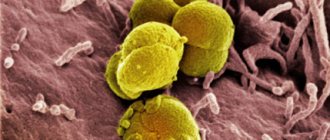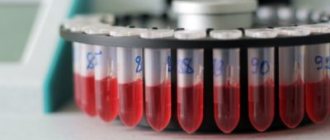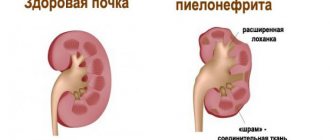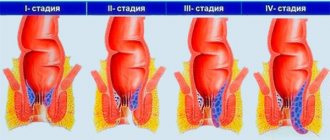This is one of the types of microorganisms that differ from other representatives in their small size. Unlike many other representatives of microflora, they do not have a cell wall, which is one of the main protective mechanisms.
They belong to the gram-negative representatives. Three main types have pathogenic properties in humans. At the same time, in gynecological practice, the species Genitalium deserves special attention, which shows tropism for the genitourinary tract of both women and men.
Due to their structural features, they cannot be classified as either viruses or bacteria. It manifests its vital activity on the mucous membranes of various organs.
They pose a great danger due to the fact that they penetrate through any biological barrier. This is important when planning pregnancy for a woman who has a history of microplasma infection.
In the environment they turn out to be unstable, and even under the influence of certain factors they can die instantly. They exhibit better stability at low ambient temperatures. For better penetration into the body, they have pathogenicity factors such as hemagglutinin and hemolysins.
What is mycoplasmosis?
This is one of the types of infectious process, which is characterized by damage to the urogenital tract.
It can affect both men and women equally. Most often, mycoplasmas are diagnosed in female representatives, for the most part this is due to the structural features of the organs of these systems.
The pathogen is easily treated with antibacterial agents after it is identified using laboratory methods.
It can lead to the development of pathologies of various organs and systems; a greater number of complications are associated with the course of pregnancy against the background of the presence of mycoplasma in the body.
This infection provokes spontaneous miscarriages, infertility, and pathologies of the fetus.
Consequences of mycoplasmosis
Infectious mycoplasmosis causes many gynecological problems. In women, the inflammatory process affects the cervical canal, provokes the appearance of salpingitis, endometritis and leads to pain in the vagina.
When mycoplasmosis occurs in a latent form, its presence is difficult to detect. Diseases are approached by the method of exclusion. The latent form always provokes miscarriages, polyhydramnios, leads to abnormal development of the protective placenta and other complications. When mycoplasmosis becomes chronic, infertility begins.
Children suffer from frequent colds of the respiratory system. They may also experience some pathologies in the urogenital tract. In little girls, the vagina and vulva are affected. And boys suffer from an inflamed bladder.
With respiratory mycoplasmosis, the child suffers from a dry cough, which bothers him greatly at night. This cough is often confused with whooping cough. It can remain dry for a whole month, and then gradually turn wet. In addition to a wet cough, wheezing in the lungs is added. Sometimes, with such mycoplasmosis, a passing rash can be observed in a child.
The incubation period for pneumonia with mycoplasmosis lasts from 2 to 6 weeks. The disease immediately manifests itself as an acute onset. The child begins to have severe headaches, suffers from constant lethargy and may even vomit.
The child first begins to suffer from pain in the joints, and a small rash and large reddish spots appear on his body. When examining the oral cavity, enlarged lymph nodes can be seen.
Men are carriers of the infection. Antibodies to mycoplasma are often found in their blood. However, during times of stress and reduced immunity, the disease is activated. Then men begin to complain of clear discharge, burning sensations and unpleasant pain in the groin.
In medical practice, there have been cases where mycoplasmosis led to the development of pilonephritis, arthritis and prostatitis.
Routes of infection
Infection with mycoplasma occurs in several ways, among which the main ones are aerosol, contact and vertical entry of the pathogen into the body.
Routes of infection:
- The most common route of transmission at present is sexual. Mycoplasma is acquired through contact with a sick person without protective equipment. The possibility of charging will depend on several factors of the body, one of the components is the state of immunity, as well as the presence of inflammatory processes in the urogenital tract and the amount of pathogen.
- The oral route is possible if there is oral sex in a person’s life. The ascending path occurs when mycoplasma penetrates the placenta of a woman who is its carrier. In this case, the accumulation of the pathogen occurs in the amniotic fluid. The risk of infection of a newborn during passage through the birth canal is quite low.
- Hematogenous infection is possible through contact with the blood of a sick person, as well as through transfusion of donor plasma.
- Translocation transfer of a pathogen through transition from one organ to another.
- The everyday way is one of the most rare cases. Theoretically, it can occur through the use of other people's personal hygiene items, as well as through untreated medical instruments.
Diagnostic measures
As you know, the clinical manifestations of mycoplasmosis are very similar to the symptoms of other diseases. And the small size of microorganisms complicates diagnosis using conventional methods. Therefore, to determine the presence of mycoplasma, the PCR (polymer chain reaction) method is used. This analysis is highly accurate, but unfortunately, it is impossible to carry out in inflammatory processes accompanied by purulent discharge.
Another effective method for detecting mycoplasma is bacteriological culture. True, it can only detect M. hominis. Unlike PCR diagnostics, it is more complex and takes a lot of time. The ELISA (enzyme-linked immunosorbent assay) method has become less accurate, but quite popular. Its accuracy is about 75%.
Ultrasound is used as an auxiliary diagnostic method. Ultrasound examination of the kidneys and bladder helps to determine the extent of the disease. It is mandatory for women who are planning to conceive, have had complicated previous births, and also suffer from chronic diseases of the pelvic organs and infertility to undergo tests to detect mycoplasma.
Causes of occurrence in women
There are quite a lot of them:
- Most often, infection occurs through sexual contact without the use of protective equipment with a person infected with this pathology. The type of sex in this case does not matter much, since it occurs during oral, vaginal and anal contact. In most cases, this links inflammation caused by mycoplasma in other organs.
- A case of reinfection.
- Failure to comply with personal hygiene rules when visiting public places is associated with the likelihood of the pathogen spreading and becoming infected. These include swimming pools, baths, saunas, restaurants, gyms. In such establishments, preventive measures and disinfection methods must be carefully observed.
- Insufficiently thorough treatment , as well as the use of drugs to which mycoplasma has developed resistance.
Treatment of mycoplasmosis
Due to the development of a large number of complications, all cases of detected mycoplasmosis are subject to treatment. It is based on antibacterial drugs and agents that increase the immunity of the macroorganism. Treatment should be carried out both for the patient himself and his sexual partners. The duration and number of courses of antibiotic therapy are determined by the attending physician and are strictly individual.
Antibacterial drugs to which mycoplasmas are not sensitive:
- Sulfonamides.
- Benzylpenicillin and Ampicillin.
- Cephalosporins.
M. hominis is resistant to macrolides - erythromycin, oleandomycin and spiramycin.
Ureaplasma urealiticum is resistant to erythromycin and tetracycline.
The main groups of antibiotics used to treat mycoplasmosis:
- Tetracycline group (Tetracycline, Doxycycline, Minocycline, Metacycline).
- Group of macrolides and azalides (Ericycline, Josamycin, Clarithromycin).
- A group of fluoroquinolones (Oflocycline, Ciprofloxacin, Sparfloxacin).
- Aminoglycoside group (Gentamicin).
As a monoinfection, urogenital mycoplasmosis is rare and is mainly detected in combination with trichomoniasis, gardnerellosis, chlamydia, candidiasis and other infections. In connection with these, drugs of the metronidazole group and antifungal drugs are included in the treatment regimen.
To normalize the functioning of the immune system, adaptogens (Saparall, extract of Eleutherococcus and Leuzea, tincture of Aralia, Ginseng and Schisandra, Pantocrine) and proteolytic enzymes (a-chymotrypsin, Wobenzym) are used.
After treatment with antibiotics, in order to normalize the vaginal microbiocenosis, eubiotics are prescribed (Acylact in suppositories for vaginal and rectal use and Bifidumbacterin).
Cure criteria:
- A woman is considered cured if, 10 days after the end of treatment and subsequently, with 3 examinations during 3 menstrual cycles, the pathogen could not be identified.
- A man is considered cured if pathogens cannot be identified within 1 month after the end of treatment.
Rice. 12. In the photo there is mycoplasma genitalium (indicated by an arrow).
Symptoms of mycoplasmosis in women
In most cases, the disease is asymptomatic, so a woman can carry the pathogen in her body for a long time and not be aware of the pathology.
The appearance of signs of the disease does not always indicate a recent infection; in most cases, the pathological process is activated after exposure to unfavorable factors on the body. These may be diseases that reduce the body's defenses, autoimmune pathologies, stress or environmental factors.
Symptoms:
- Most often it is characterized by the development of an inflammatory process in the vagina , cervix, and its mucous membrane. Such a serious problem as sluggish oophoritis can lead to the formation of infertility or the development of adhesions in the ovaries.
- On the part of the reproductive system, mycoplasma is characterized by the appearance of discharge that has a transparent color , is not abundant and is characterized by itching and burning during urination, as well as painful sexual intercourse. From the internal organs, this is a feeling of nagging pain in the lower abdomen.
- When the urinary system is involved in the pathological process, cystitis and pyelonephritis develop . In women, body temperature almost always rises, urination becomes painful with pain and discomfort in the lumbar region.
- Infertility can be associated with both an inflammatory process and menstrual irregularities.
- During pregnancy, the risk of miscarriage , fetoplacental insufficiency, chorioamnionitis, polyhydramnios, and premature birth increases. Most often, children from mothers infected with mycoplasmas are born prematurely; many have extragenital pathology.
Symptoms
Symptoms of Mycoplasma genitalium
This type of mycoplasma is very dangerous. It can be detected in people of different sexes. Symptoms often occur when urinating. The person feels some pain and a burning sensation in the genitals. Mycoplasma affects the urethra, causing the adjacent tissues to become inflamed.
If a woman was infected with Mycoplasma genitalium during sexual intercourse, then sharp pain appears on the walls of the vagina. Often the infection does not appear immediately; first there is an incubation period (7-10 days). In rare cases, this period may be one month.
Symptoms of Mycoplasma pneumonia
This type of mycoplasma causes pneumonia. The disease develops gradually. First, a person begins to suffer from a painful cough with phlegm. Patients complain of a runny nose, nasal congestion and sore throat. On examination, you can see redness of the pharynx. If the inflammatory process has already reached the bronchi, then dry wheezing becomes audible, accompanied by harsh breathing.
In the most severe cases, Mycoplasma pneumonia causes complications on the heart and nervous system.
Symptoms of Mycoplasma hominis
Mycoplasma hominis is found in the genitourinary tract of all people. If she is given certain conditions, she begins to develop dangerous pathologies. Patients experience painful urination. Sometimes the symptoms of Mycoplasma hominis infection are hidden.
Mycoplasmosis in women
With mycoplasmosis, women may experience:
- Urethritis. This is an inflammation of the urethra. The pain increases during urination. It is characterized as burning, stinging and itching.
- Vaginitis. This is a mycoplasma infection of the vaginal mucosa. A woman feels an unpleasant odor from intimate places, feels burning and itching, and sees mucopurulent discharge in copious amounts. If you have sexual intercourse during vaginitis, the process will be very painful.
- Endometritis. The disease occurs when the infection reaches the mucous membrane of the cervix and the uterus itself. The woman feels severe discomfort and pain in the lower abdomen. Light bleeding may occur between natural periods. Endometritis often causes infertility and early miscarriages.
- Adnexitis. This is a lesion by inflammatory processes of the uterine appendages. With adnexitis, the fallopian tubes swell. As a result, women are often diagnosed with tubal infertility.
In men
Men are also characterized by an inflammatory process in the genitourinary area. The following diseases occur in men:
- Urethritis. This is a disease of the urethra. The man feels severe pain and burning, which intensifies during urination. The pain increases greatly with ejaculation.
- Prostatitis. This is a disease of the prostate gland. The man feels pain in the perineum. The pain increases with pressure on this area. Other symptoms of prostatitis: pain during sexual intercourse, decreased potency, lack of libido.
- Orchitis. This is a disease of male testicles. The pain permeates the scrotum and intensifies with pressure.
- Male infertility. As a result of prostatitis and related diseases, sperm quality is seriously affected. A man cannot conceive his children.
Mycoplasmosis during pregnancy
In most cases, women are diagnosed with mycoplasmosis already during pregnancy, when registration occurs.
This is most often due to the fact that only a small number of women turn to specialists for pre-conception preparation.
First of all, mycoplasma can interfere with the normal course of pregnancy; from an early stage, such women are at risk of miscarriage.
During its development, the placenta changes in structure and also acquires functional defects.
With the development of the inflammatory process in the area of the external and internal genital organs, there is a possibility of the pathogen penetrating through the placental tissue and developing inflammation in the amniotic fluid and membranes. There is also a threat of damage to the fetus, manifested by sepsis, pneumonia, conjunctivitis, as well as a decrease in the functioning of the immune system.
Treatment and prevention
Treatment of mycoplasmosis in women is carried out with the help of antibiotics, agents for restoring microflora in the intestines and vitamin complexes. The drug, dosage and regimen for its use must be prescribed by the attending physician during a face-to-face consultation and based on test results. In some cases, there may be a combination of antibiotics from different groups.
Goal of treatment:
- Activate the immune system and enable the body to fight infection.
- Destroy pathogenic microorganisms.
- Restore the protective functions of the mucous membranes of the vagina and uterus.
- Restore motility of the fallopian tubes.
- Normalize the microflora of the vagina and intestines after taking antibiotics.
Tetracyclines
Almost all tetracycline antibiotics have a broad spectrum of action. They inhibit protein synthesis, thereby preventing the proliferation of microorganisms.
To treat symptoms of mycoplasma in women, the following are prescribed:
- Doxycycline (Unidosk-Solutab, Doxibene, Vibromycin), the initial dose is 200 mg on the first day of treatment, subsequently 100 mg. The duration of treatment is from 10 to 21 days.
- Tetracycline hydrochloride is taken 200 mg every 6 hours for at least 10 days.
- Oletterin (tetracycline in combination with oleandomycin), prescribed 250 mg 4 times a day for 5 to 7 days.
When using these drugs, side effects from the digestive system (nausea, vomiting, stool upset), as well as dizziness, headache, photosensitivity and allergic reactions may occur.
Most often, treatment for mycoplasmosis is recommended with drugs from the tetracycline series. Despite the fact that they have been used for several decades, activity against pathogens remains high. The drug of choice in this case is Doxycycline; it has high bioavailability and is well tolerated without side effects.
Types of mycoplasma
There are several types of microplasma infection.
First of all, these are several types of process flow:
- An acute process , which is characterized by vivid symptoms and pronounced signs of inflammation.
- Subacute or chronic. The symptoms will be mildly expressed, the woman may not pay attention to them until complications develop or a period of exacerbation.
- Hidden current. The diagnosis of mycoplasma is established only with the help of laboratory tests.
Type of infection depending on the damage to the anatomical area:
- Respiratory damage. Spread of mycoplasma throughout the respiratory system.
- Urogenital. Mycoplasma in this case is found on the genitals, as well as all organs of the urinary system.
What is mycoplasma
Mycoplasma is a type of single-celled microorganisms with no cell membrane. Microbes can be found in earthen soil, anthracite, and hot underground waters. They are able to reproduce in cell-free environments, but spend their entire life cycle only in the bodies of warm-blooded creatures.
Getting into cellular tissues, they destroy them, pumping out nutrients. In the body of animals and humans, it affects the mucous membranes, causing the disease “mycoplasmosis” of the respiratory system, genitourinary system, and musculoskeletal system.
Mycoplasma in women causes different symptoms, depending on the type of microbe. Therefore, treatment is chosen based on the disease.
Types of microorganisms:
- Mycoplasma salivarium, Mycoplasma orale - are part of the microorganisms that inhabit the oral mucosa and do not cause the development of diseases.
- Mycoplasma pneumonia – provokes respiratory infections, the first stage of deep pneumonia, pathological conditions in the bronchi.
- Mycoplasma genitalium is a bacterium that causes mycoplasmosis infection in the pelvic organs.
- Mycoplasma hominis is a relatively harmless microorganism. Inhabits the mucous membranes of the mouth, genitals, and cerebrospinal fluid of the musculoskeletal system. With good immunity, it is in a dormant state and does not provoke the development of the disease. If activated, it becomes the basis for inflammation in the genitals.
- Ureaplasma urealytium is a bacterium that causes infection of healthy cells with ureaplasmosis.
- Mycoplasma fermentans - do not cause disease. Found in 30% of newborn girls and boys. Over time, they disappear spontaneously.
- Mycoplasma penetrans - according to recent scientific research, is considered a marker of HIV infection. Most common in homosexual men (more than 40%).
Diagnostics
Since mycoplasmosis is very often asymptomatic, it is detected in most cases after a random examination. But in some cases, the doctor may suspect the presence of an infectious process based on medical history or the presence of various diseases that often recur.
Women with infertility, as well as cases of miscarriage and the development of defects in children deserve special attention.
Diagnostics:
- To make a diagnosis, an examination by a specialist is required , as well as clarification of the health status of the sexual partner. A gynecologist can assess the condition of the mucous membrane of the vagina, cervix, as well as the nature of the discharge and the degree of inflammation. A mandatory point is the collection of biological material for further research.
- If necessary, consultation with a urologist or dermatovenerologist may be required.
- Several laboratory tests can be used at once. One of them is bacteriological culture of vaginal contents. In this case, mycoplasmas are not detected, but the presence of a concomitant infection can be determined or the nature of the microflora can be assessed.
- Polymerase chain reaction. A diagnostic method for determining the presence and quantity of the pathogen; if necessary, additional reproduction occurs in order to type the strain. The assessment is made on the basis of genetic material obtained from microorganisms.
- Serological studies evaluate the reaction of the immune system , they clarify the nature of the inflammatory process, whether it is fresh or already experienced.
- Instrumental methods are not required to detect mycoplasmosis.
Diagnosis of mycoplasmosis
It is not easy to detect the presence of infection in a woman due to the very small size of the microorganisms that provoke mycoplasmosis. For this, an examination in a gynecological chair, symptoms, and examination of smears for microflora are not enough. There are different types of diagnosis of mycoplasmosis in women.
Typically, to determine the disease, DNA is studied using the polymerase chain reaction (PCR). As a result of the analysis, the presence of mycoplasma DNA is determined. This method of determination has a high level of accuracy of the result obtained (95%). The material for the study is blood or scraping of the urogenital epithelium. Diagnostics using the PCR method will not give reliable results in the case of purulent discharge - under such conditions, determining the presence of mycoplasma DNA is not possible.
If it is impossible to carry out a PCR analysis, the enzyme-linked immunosorbent assay (ELISA) method is used, the accuracy of which is 70%. There is a similar method of direct immunofluorescence (DIF), its accuracy is also low. The cost of such methods is low, results are obtained quickly: in 2 hours.
To obtain an analysis of 100% accuracy, bacteriological culture is performed. The duration of obtaining the result is a week. The difficulty of carrying out bacterial sowing lies in the fact that it requires a special nutrient medium. To carry out the analysis, vaginal discharge and urethral discharge are used.
The results of studies to detect the presence of mycoplasma hominis microorganisms should be repeated after a month to confirm the diagnosis. An additional test for diagnosing mycoplasmosis is ultrasound; it will determine the presence of inflammation of the genitourinary system.
Treatment of mycoplasma
Drugs
The basis of therapy for microplasma infection is antibacterial agents; it is recommended to select them after determining the sensitivity of the pathogen to the substances.
They can be taken systemically as monotherapy or in combination with local drugs. The course of treatment is also selected individually.
The most common antibiotics used for mycoplasma include:
- Sumamed is an erythromycin drug that combines several effects. Acts predominantly on gram-positive bacteria. The mechanism of action is based on the accumulation of the drug in the cells, with a high concentration remaining precisely in those parts where the cells are affected by the pathogen. The concentration of sumamed in plasma is lower than intracellular. It is due to this property that the fight against intracellular microorganisms occurs. The course of treatment is usually not long, on average it can range from 3 to 5 days, this is due to the fact that the drug remains in the cells for several days and continues its effect without new portions entering the blood. Pregnant women are allowed to take it only if the benefit outweighs the possible risk.
- Azithromycin. A drug with a bactericidal mechanism of action that acts primarily on the site of pathogen concentration. It is highly effective against diseases of the genitourinary tract, which is why it is often used against sexually transmitted infections. The only drawback of the erythromycin group of drugs is that a large number of bacteria have developed pronounced resistance to them. The average course of therapy is a week, the advantage is a single use, i.e. The break between doses is 24 hours.
- Doxycycline. Doxycycline, which is prescribed for mycoplasma for two weeks, has a similar mechanism of action. The advantage of taking it is that it is approved for use during pregnancy. It also has a solution form that is administered intravenously.
- Unidox. A drug that is used for various diseases, including sexually transmitted diseases. It shows its effectiveness only during an active process, when the metabolism of cell membranes and their destruction, as well as the destruction of dividing cells, are disrupted. It does not show its effectiveness when carried, without the active manifestation of the process. The Solutab form provides high bioavailability. Already two hours after consumption, the manifestation of its effect begins.
- Vilprafen , a drug from the group of macrolides that are highly effective against mycoplasmas. It disrupts the processes of protein synthesis in bacteria. Within a few days after administration, the required amount of the product accumulates. But nevertheless, the course is at least two weeks in order to destroy the pathogen at all stages of development.
- Amoxiclav , a product with a combined composition. It is highly stable due to the presence of clavulonic acid, which protects penicillin from destruction by bacteria. It tends to accumulate in the tissues of the genital organs and pass through the placenta, so in some cases it will be contraindicated for use. It is recommended to take at different intervals, depending on the chosen dosage.
- Tetracycline. The drug is prescribed only after the sensitivity of mycoplasma to it has been determined. It has a large number of side effects and contraindications; it is not recommended to use during pregnancy.
Vilprafen
Unidox
Tetracycline
Sumamed
Doxycycline
Azithromycin
Amoxiclav
Candles
Insufficient attention is paid to the local treatment of mycoplasmosis, since most specialists ignore and consider this method ineffective. But as practice shows, it is drugs with a limited mechanism of action that will help solve the problem in difficult situations.
One of them is the period of pregnancy, when the doctor is faced with a dilemma between whether to take drugs for a woman from the group of antibiotics, or to refuse treatment altogether and weigh the possible risks.
In most cases, it is systemic drugs that are contraindicated during this period. Therefore, topical drugs come to the rescue.
These include both specific agents and general ones. The latter include suppositories or tablets that destroy all the flora in a woman’s vagina, that is, in addition to mycoplasma, beneficial bacteria are also killed.
These are tools such as:
- Betadine. Suppositories containing iodine. This substance has an antiseptic and slightly anti-inflammatory effect. Practice shows that it is quite effective, but has a number of limitations, including the presence of thyroid pathology and pregnancy after the second month. The course of treatment for mycoplasma is no more than two weeks. 1 suppository per day is inserted into the vagina.
- Hexicon or suppositories with chlorhexidine . The active substance in this case is a powerful antiseptic. The advantage of its use is the effective destruction of microorganisms. It can be prescribed to all people who do not have hypersensitivity to it, and is also allowed to be taken during pregnancy. In some cases, there may be a side effect from taking it, manifested by a violation of the vaginal microflora.
- In the fight against mycoplasma, immunostimulating agents are effective . The most common among them are Genferon and Viferon . They are necessary for women when both local and systemic defenses are reduced. Among antibacterial agents, ointments are used, for example, Tetracycline . Very often, mycoplasma can be found in the body as a combined problem with other sexually transmitted infections, so additional medications are always required.
- Another drug that is effective against mycoplasma is Terzhinan . Vaginal tablets, which have a complex composition and mechanism of action, contain antimicrobial and antimycotic agents, in addition, they contain a hormonal part that enhances the effect of the previous substances. It is prescribed for mycoplasma according to the scheme, a course lasting on average 10 - 20 days. It should be noted that in some cases women do not use this drug due to itching and burning. This is not a manifestation of a complex allergic reaction, but an adaptation of the mucous membrane to the drug, so treatment should not be interrupted. In addition, the advantage of the product is the possibility of use during menstruation.
Betadine
Hexicon
Chlorhexidine
Viferon
Genferon
Terzhinan
Treatment
Treatment of mycoplasmosis in women is prescribed in a comprehensive manner to influence mycoplasma and increase protective immunity.
Select drugs that are active not only against mycoplasma, but also against associated bacteria, viruses and fungi:
- tetracycline antibiotics for mycoplasmosis;
- fungal remedies;
- antiprotozoal agents;
- macrolides.
Table 2: Main therapeutic methods of antibiotic treatment:
| Drugs | Instructions for use/diagram |
| Antibiotics: Doxycycline, Erythromycin, Ofloxacin, Azithromycin, Midecamycin, Minocycline, Pefloxacin, Spiramycin. For pregnant women at the 12th week of fetal development, Erythromycin and Josamycin (Vilprafen) are used. Tetracycline antibiotic | Therapy is carried out under the supervision of a physician until completion of treatment:
|
Antibiotic for pregnant women and children | Josamycin (Josamycin) was created specifically for pregnant women, it does not harm the fetus. It is also used for children. Pregnant women are prescribed 0.5 g orally three times a day for a course of 7 days. For children weighing up to 45 kg, the dose of 50 mg/kg is divided into three times. Course – 7 days. |
Restoration of microflora of the genital tract and intestines
After using antibiotics in tablets and suppositories (Vilprafen), the mycoplasma infection recedes, but they also aggravate the benign (beneficial) microflora.
To restore it you need:
- take dental medications internally: Linex, Hilak Forte, bifidumbacterin;
- insert Terzhinan and Vagilak suppositories into the vagina, and douche with whey.
To ensure that antibiotics work effectively and have fewer side effects, Wobenzyma tablets are consumed a week before taking them - 5 pieces each. 3 times/day. At the same time, take multivitamins.
A fibrinolytic, immunomodulatory and anti-inflammatory agent
Therapy of mycoplasmosis in children
In children, the disease can be severe, so they should be hospitalized.
The following drugs are prescribed for therapy:
- antibacterial: Azithromycin (Sumammed) – 10 mg/kg – 6 days;
- antipyretics: Nurofen - 2.5 ml x 2 times - for children under 3 years old, 5 ml x 3 times - for children up to 3-6 years old, 7.5 ml x 4 times - for children up to 6-12 years old, 10 ml x 4 times – for children over 12 years old;
- probiotics: Bifiform – 1 capsule x 2-3 times;
- immunostimulants (if necessary): Leukocyte interferon for instillation into the nose every 2 hours;
- drinking plenty of water;
- washing the genitals with decoctions of medicinal herbs.
Vitamins for mycoplasmosis and diet
To protect the liver after taking antibiotics for mycoplasmosis, it is necessary to take a herbal preparation - Hofitol. Pregnant women are prescribed treatment with hepatoprotectors and vitamins to reduce fetal malformations.
Immunostimulating drugs are prescribed for the treatment of mycoplasmosis in women and children in addition to the main treatment: Imunofan and Interferon, which will speed up the recovery process, eliminate pathology and increase the body's defenses. The price of Imunofan is 750-850 rubles, the price of Interferon is 9984-9905 rubles.
To improve the body’s immune response, the doctor usually prescribes vitamins: C, P, E, groups B, K and D.
It is also necessary to include foods containing essential vitamins in your daily diet:
- beef liver, kidneys and tongue;
- rabbit, chicken, beef and lamb meat;
- fish and seafood;
- cheese and eggs;
- lactic acid products and milk;
- legumes, peas and vegetables, fruits and berries;
- vegetable oils: corn, cottonseed, sunflower;
- spinach and other greens;
- pumpkin seeds, bran, rolled oats;
- wholemeal bread.
Important. You should avoid alcohol, fatty foods, too salty and spicy foods, smoked foods, too sweet foods, strong tea and coffee.
Physiotherapy for mycoplasmosis and complications
In order to relieve pain and reduce swelling, improve blood microcirculation in the area of inflammation, reduce the permeability of vascular walls, and provide an anti-inflammatory effect, the following is used:
- Laser therapy using stable and labile methods. According to the stable technique, the emitter is not moved. It is fixed in contact with the area throughout the entire procedure. According to the labile technique, the irradiation zone is divided into fields and then the emitter is moved arbitrarily. In case of complications, a urethral attachment is used to influence the urethra. Low-intensity laser radiation is used to treat inflammation of the sinocarotid and projection zones over the liver, coccyx, and pubis.
- ILBI – intravenous laser irradiation of blood to increase local immunity. It activates the systemic healing mechanisms of the body, increases the efficiency of the functions of the blood supply system, has analgesic, antioxidant, desensitizing, bio- and immunostimulating, detoxifying and even antiarrhythmic effects. It also dilates blood vessels, destroys bacteria, relieves swelling and inflammation.
- Microwave thermotherapy: transrectal or transurectal (hyperthermia) for both women and men. The mucous membrane of the urethra (in men also of the prostate gland) is heated superficially to a depth of 5 mm. The goal is sanitation of the urogenital tract. This will increase the effect of drug use during local therapy. During the procedure, the temperature is gradually raised to 39-45°C in the urethra or rectum. In men with urethritis and prostatitis, rectal heating is combined with a laser, magnetic field (traveling) or electrophoresis. The procedure shortens treatment time, reduces leukocytosis, increases blood flow and increases the concentration of lecithin grains.
- Magnetotherapy (traveling magnetic hollow) with drugs. For this purpose, the Intramag device (male and female versions) is used. Along with intraurethral effects on the genitourinary organs, electrophoresis is performed using a special irrigating catheter.
- Electrophoresis with medications: antibiotics, painkillers, products with trace elements and enzymes. The procedure of medicinal electrophoresis is carried out in case of chronic inflammation of the urethra and for the introduction of the drugs used into the vagina, rectum, and urethra. Can be combined with galvanic mud treatment. At the same time, skin capillaries are stimulated, the inflammatory-edematous process is eliminated, tissues are nourished, they are regenerated deep under the skin and micromassage occurs.
- Ozone therapy: autohemotherapy with ozone, rectal insufflation with a mixture of ozone and oxygen. High concentrations of ozone with a high oxidative potential are aimed at providing a bactericidal, fungicidal and virusicidal effect against the companions of mycoplasma - bacteria, viruses and fungi, as well as a therapeutic effect for light activation of metabolic processes, correction of immunodeficiency, reduction of blood viscosity, normalization of metabolic processes in tissues: gas exchange and microhemocirculation.
The video in this article provides information about methods of infection and treatment of mycoplasmosis in women, pregnant women and children.
Traditional medicine methods
Table 3: Recipes for pregnant women for mycoplasmosis:
| Means | How to cook | How to use |
| Infusions for oral administration | Goldenrod herb (3 tablespoons) is steamed with boiling water (3 tablespoons) and allowed to stand for 45 minutes. A collection is prepared from hogweed, wintergreen and wintergreen in equal proportions. Pour boiling water (3-4 tbsp.) into 15 g of the collection and leave for 50-60 minutes. |
|
| Douching, washing | A collection is prepared from oak bark (2 tbsp.), boron uterus (1 tbsp.) and the raw materials are steamed with boiling water (1.5 tbsp.). Leave for 45 minutes. Steam chamomile or calendula flowers: for 1 liter of boiling water – 2 tbsp. l. raw materials and let it brew for 50-60 minutes. | Douching is carried out in the morning and evening. Course – 10 days. The genitals are washed with the infusion and douching is carried out 2 times a day for a course of 20-30 days. |
Herbal medicine for mycoplasmosis for children as an addition to medications can be prepared as follows:
- Decoction: steam with 2 cups of boiling water, 2 tbsp. l. a collection of birch leaves, knotweed and immortelle (3 tbsp each) and plantain (4 tbsp), let it brew for 10 hours and then boil for another 1-2 minutes. Separate the herb from the decoction and give the child 50 ml of water throughout the day.
- Steam: pour boiling water (300 ml) over a mixture of boron uterus (1 tbsp) and oak bark (2 tbsp) and let it brew for 45-60 minutes. The external genital organs are washed with a warm solution.
- Infusion: steam sage and eucalyptus, chamomile, St. John's wort and celandine (0.5 tsp each) with boiling water (1 tbsp). Close the container with a lid and let it brew for 45-60 minutes. The grounds are separated and the genitals and groin area are washed.
Table 4: Medicinal herbs for mycoplasmosis for adult women:
| Medicinal drug/herbs | How to cook | How to use |
| Infusion from a collection of herbs: St. John's wort (2 tbsp.) and meadowsweet (4 tbsp.) for oral administration | Steam 50% of the harvest with 1 liter of boiling water, let it simmer for another 10 minutes and leave for 2 hours. Filter through gauze. | Drink 15 minutes before meals three times, 1 tbsp. l. Course – 2-3 weeks. |
| Infusion for oral administration, washing, douching and baths of St. John's wort (2 tbsp.), Elderberry (3 tbsp.) | Steam 50% of the collection with 1 liter of boiling water and boil for another 10 minutes, infuse and squeeze. | Take ½ tbsp orally. three times a day before meals. Water procedures are performed at night until the symptoms of mycoplasmosis disappear. |
| An infusion for oral administration against inflammation from herbs: chamomile, blue cornflower, knotweed, St. John's wort and corn silk, taken in equal proportions. | Pour 300 ml of boiling water into 1 tbsp. l. collection and let it brew for 60 minutes. Strain through a gauze filter. | Drink half a glass three times a day before meals. Course 2-3 weeks. |
| Oral infusion of goldenrod for mycoplasmosis | They insist on 3 tbsp. boil raw materials (3 tbsp) for 60 minutes. | After filtering, drink 1/2 tbsp. 4-6 times/day. Course 21 days. |
| Garlic paste for oral administration | For the paste you will need garlic (150 g), vegetable oil (150 ml), salt, lemon juice (or vinegar) to taste. Everything is mixed in a blender. | The paste is added to vegetable salads instead of sour cream, distributed over a piece of bread. Eat daily 1-2 times a day until mycoplasmosis disappears. |
Filtration of infusions
Prevention and prognosis
Since mycoplasmosis is a disease transmitted through sexual contact, there is only one way to prevent it - using contraception and maintaining a decent sex life.
Important! After casual sexual contact, it is recommended to use Chlorhexidine, but this is not a complete guarantee that infection will not occur.
Immediately after suspicion of infection arises, you must seek help from a medical facility. At any stage of development, the disease is curable. The main thing is to promptly identify the pathogen and undergo proper treatment.
Despite the fact that mycoplasmas are part of the opportunistic microflora, the disease caused by them is not as harmless as it might seem at first glance. That is why treatment of mycoplasmosis in women must begin immediately.
Complications
Complications are as follows:
- The most common are the development of infertility, as well as during pregnancy - premature birth and spontaneous miscarriages at different stages. Disturbances in the functioning of the placenta are very common, which leads to its insufficiency, as well as structural abnormalities. If it does not work properly, oxygen deficiency in the fetus may occur.
- Chronic endometritis, oophoritis and vaginitis occur in women.
- When the pulmonary system is affected, the biggest problem is the formation of bronchiectasis, which is an expansion of the walls of the small bronchi.
- The nervous system is affected by the development of encephalitis and neuritis.
- The genitourinary system also suffers in the absence of treatment; women experience pyelonephritis, urethritis and cystitis of microplasma etiology.
- When the fetus is infected with mycoplasma, the formation and further formation of defects in the visual, digestive and nervous systems is disrupted.
Signs of mycoplasmosis in men
The incubation period in men ranges from 2 days to 1 month, depending on the general state of health, the person’s immune system, age and living conditions. Men practically do not have a latent form of mycoplasmosis, so they are rarely carriers of the infection.
Mycoplasma genitalium in men most often manifests itself in the form of urethritis and has a set of corresponding symptoms:
- burning and pain in the urethra when urinating;
- false urge to urinate;
- itching and redness of the glans penis;
- urethral discharge, which may not have an odor;
- pain in the groin area indicates inflammation of the prostate;
- when mycoplasma spreads to the testicles, swelling may occur;
- the ability to have an erection decreases and can lead to impotence;
- depending on the intensity of the process, a man’s temperature may rise;
- in its advanced form, mycoplasmosis can cause male infertility; the parasites reduce the motor activity of sperm and affect their production.
Prevention
Prevention measures:
- Includes a set of activities that will be aimed at regulating sexual life.
- First of all, people who want to protect themselves from mycoplasmosis, as well as those who want to prevent the development of relapse, are advised to limit the number of sexual partners.
- A person with whom a woman has sexual intercourse without protection should be examined for the presence of infections.
- Avoid casual contact without a condom.
- Regularly self-examine for the occurrence and treat the presence of sexually transmitted infections.
- Refusal to provide commercial sex.
- Carefully observe the rules of personal hygiene after visiting public places, mainly baths, saunas and swimming pools.
- When the body’s immune forces decrease, carry out preventive courses to strengthen them and maintain them normal.
- Visit your gynecologist regularly and get tested for chlamydia and other dangerous infections.
Prevention of infection
To ensure that mycoplasma genitalium does not progress in the body of a woman or man, you should carefully monitor your health:
- Avoid casual sex. When having intimate relationships, be sure to use contraceptives.
- Limit the consumption of alcoholic beverages.
- Play sports, lead an active lifestyle, thereby strengthening the body. Don't overeat, eat healthy foods and watch your weight.
- Follow the rules of intimate hygiene.
- If symptoms of the disease appear, you should immediately undergo examination.
- Under no circumstances should you self-medicate.
In conclusion, it is worth noting that any treatment should be carried out only after consultation with a doctor.
Forecast
The disease is completely curable at any stage. The main thing is to undergo a detailed examination, identify the pathogen and undergo treatment. Despite the fact that mycoplasmas are recognized as opportunistic flora, the disease they cause is not at all harmless.
It can lead to serious inflammatory processes and even tragedies - the loss of a child.
Therefore, even minor symptoms should not be ignored and hope for self-healing. To maintain your health, it is better to immediately consult a doctor, who will either rule out the presence of mycoplasmas or prescribe the correct treatment. Colpitis in women: symptoms and treatment Balanoposthitis: symptoms, photos, treatment and prognosis
Mycoplasmosis in cats and dogs
Several types of mycoplasmas have been isolated from cats and dogs, which cause diseases when the immune system is weakened: Mycoplasma felis, Mycoplasma gatae (in cats) and Mycoplasma cynos (in dogs). Bacteria are found in completely healthy animals and in diseases associated with chlamydia and herpes viruses. In dogs, the species Mycoplasma cynos is cultured from the respiratory tract, but only puppies or adult allergic dogs suffer from respiratory mycoplasmosis. Mycoplasmas quickly die outside the animal's body.
For healthy people, these pathogens are not dangerous and there are no confirmed facts of transmission of mycoplasmas from animals to humans.
Symptoms of mycoplasmosis in cats and dogs are conjunctivitis with lacrimation, hyperemia of the mucous membrane of one or both eyes, discharge of pus or mucus, swelling and spasm of the eyelids. Of the respiratory forms, rhinitis prevails; with the development of urogenital infection, urethritis and cystitis, vaginitis and endometritis, as well as inflammation of the prostate gland and balanoposthitis (inflammation of the skin of the head of the penis and the inner layer of the foreskin) are diagnosed. The spread of mycoplasmas causes arthritis with the destruction of intra-articular cartilage. The formation of subcutaneous ulcers is possible.
Mycoplasmas in pregnant cats and dogs can provoke premature birth; if infected before pregnancy, congenital deformities may develop in kittens and puppies.
Diagnosis of mycoplasmosis is carried out using the PCR method, using sputum and swabs from the trachea (bronchial tubes), smears from the conjunctiva and genitals as the material. Mycoplasmosis is treated with doxycycline, but it is contraindicated in puppies and kittens under 6 months of age. For conjunctivitis, ointments with chloramphenicol or tetracycline, drops with novocaine and hydrocortisone are used topically. With prolonged use of hormonal drugs, ulceration of the cornea of the eye is possible. Reserve antibiotics – erythromycin, gentamicin, fotrquinolones (ofloxacin). There is no vaccine against mycoplasmosis; the main prevention is proper nutrition and adequate physical activity of animals.
How can you get infected?
The source of infection is a sick person or a bacteria carrier. There are 2 ways of transmission of mycoplasmosis:
- Sexual transmission: this microorganism lives on the mucous membrane of the genitourinary system, infection occurs during sexual contact;
- The vertical route of transmission is infection of the child during childbirth; such cases are rare, since during pregnancy the woman undergoes a medical examination and, if mycoplasma carriage is detected, receives the necessary treatment.
The cause of mycoplasmosis is the reproduction of mycoplasma in a woman’s body. Unprotected sexual intercourse increases the risk of developing such a disease (only barrier methods of contraception will help prevent infection). Since the Mollicutes class of bacteria lives on the mucous membranes of healthy people, exposure to certain factors can provoke its proliferation:
- long-term use of antibiotics suppresses the microflora of the genital organs, which allows mycoplasma to multiply uncontrollably;
- diseases leading to immunodeficiency;
- frequent stress activates pathological processes throughout the body and reduces resistance to infections;
- taking glucorticosteroids;
- the presence of chronic inflammatory diseases;
- hormonal disorders;
- dysbacteriosis;
- carrying out invasive (requiring penetration into the body) measures for diagnosis or treatment (in the absence of proper care for the postoperative wound);
- pregnancy (during this period, hormonal levels change, resistance to infections decreases, diseases that were previously chronic become worse);
- poor nutrition;
- alcohol abuse (alcohol-containing liquids cause changes in the male gonads, provoking changes in the microflora);
- promiscuous, unprotected sexual intercourse.
Incubation period of mycoplasmosis
The duration of the latent course of the disease is individual and depends on many factors. On average, the incubation period lasts from several days to a week or two. Less often it is 25 days. The time period from infection with pathogenic flora to the appearance of the first signs is influenced by:
- The number of mycoplasmas that have entered the body.
- The state of the body at the time of infection (presence of recent diseases, immunodeficiency, hypovitaminosis, chronic inflammation).
- The type of bacteria that caused the pathological process.
There are cases of asymptomatic disease (mycoplasma carriage). It is important to understand that the absence of symptoms does not mean that a person is healthy - even a latent form of the disease poses a threat.
Mycoplasmosis therapy
There is still no consensus on the advisability of treating mycoplasmosis. Some doctors believe that the bacterium Mycoplasma hominis (which is opportunistic) does not cause any diseases if there are no provoking factors. This means that a patient diagnosed with this bacterium does not need therapy. This is especially true for those in whom the disease does not manifest itself in any way.
However, if symptoms do appear, then therapy is necessary. How to treat a patient is decided exclusively by specialists, based on the specific type of bacteria and the symptoms that appear.
Treatment, as a rule, is complex: the patient is prescribed antibacterial, antifungal and antiparasitic drugs (since mycoplasma is often not the only harmful microorganism in the patient).
In addition to these medications, medications are prescribed that increase immunity - this will make it easier for the body to fight mycoplasma, and recovery will come faster. To restore microflora, probiotics are prescribed, and with the help of multivitamin complexes, hypovitaminosis is treated and the general condition of the patient improves. Sometimes physical therapy and urethral douching are prescribed.
It is important for the patient to realize that treatment will be effective only if the recommendations of the attending physician are strictly followed. It is necessary to strictly observe the dosage of drugs and adhere to the course of treatment. Without complete treatment, the patient risks not only aggravating the disease, but also acquiring resistance to antibiotics, which will significantly complicate the further treatment process.
14 days after stopping medication, it is necessary to conduct a culture test, and a month later, a polymerase chain reaction. Conclusions about the effectiveness of therapy will be based on the results of these tests.
If mycoplasmosis is diagnosed in a pregnant woman, treatment is carried out only if there is a risk to the health of the fetus and mother.
Classification and pathogen
The causative agent of mycoplasmosis is microorganisms from the Mycoplasmatacea family.
Their size ranges from 150 to 450 nm, which is significantly smaller than that of other bacteria. Due to its size, mycoplasma is almost impossible to see in a conventional light microscope. These parasites are ubiquitous in the environment. This includes both soil and wastewater. They can cause diseases not only in humans, but also in animals. Mycoplasmosis in humans is caused by two genera of mycoplasmas: Mycoplasma and Ureaplasma.
They, in turn, are divided into several types:
- M. pneumonia – causes pulmonary (respiratory) mycoplasmosis;
- M. incognitus – causes a generalized form of mycoplasmosis;
- M. hominis – causes the urogenital form of mycoplasmosis;
- M. genitalium - causes the urogenital form of mycoplasmosis;
- U. urealyticum - causes the urogenital form of mycoplasmosis.
The causative agents of the disease are sensitive to antibacterial drugs from the group of macrolides, fluoroquinolones and tetracyclines. They also die outside the human body from boiling, disinfectant solutions and exposure to ultraviolet radiation.
Prevention: how to avoid mycoplasmosis
Due to the fact that mycoplasma is mainly transmitted sexually, the best method of preventing infection by the microorganism is the use of condoms. The barrier method of contraception will reliably protect against damage by foreign pathogenic flora during sexual intercourse.
To monitor your own health and prevent complications of various diseases, you should visit specialists for routine preventive examinations (for women this is a gynecologist, for men - a urologist).
Attention!
This article is posted for informational purposes only and under no circumstances constitutes scientific material or medical advice and should not serve as a substitute for an in-person consultation with a professional physician.
For diagnostics, diagnosis and treatment, contact qualified doctors! Number of reads: Publication date:
Manifestations and symptoms of mycoplasma
It should immediately be noted the high frequency of asymptomatic processes.
According to statistics, from 40 to 70% of people infected with M. genitalium will not feel this.
When the epithelium of the pharynx or rectum is damaged, there are almost never any manifestations.
The reason is the absence of a cell wall that would irritate the immune system and the intracellular localization of pathogens.
Active inflammation of the genitourinary organs with mycoplasmosis occurs in 30-50% of people.
It begins after a short incubation period of 7-14 days, the maximum period is 25 days.
Subsequently, symptoms develop that indicate an inflammatory process in the part of the genitourinary system that has become infected.
Routes of transmission of mycoplasmas
There are the following routes of transmission of mycoplasmas:
- Airborne. Only one type of mycoplasma can be transmitted through coughing or sneezing: mycoplasma pneumoniae. Respiratory mycoplasmosis can be contracted from a patient during the first 10 days from the moment the first symptoms appear. If the disease becomes chronic, the pathogen is released into the external environment for another 3 months (even if the patient feels well).
- Sexual contact. According to statistics, women are more often carriers of mycoplasma hominis and genitalium. During unprotected sexual intercourse or during oral sex, a man can “pick up” the microorganism and become ill with mycoplasmosis. When kissing, it is impossible to get a disease caused by mycoplasmas or ureaplasmas.
- Other routes of transmission. Transmission of microorganisms is also possible hematogenously: through transfusion of contaminated blood or organ transplantation. In extremely rare cases, mycoplasma can enter the human body when using poorly sterilized medical instruments.
Need to know! Children are at risk, since respiratory mycoplasmosis is transmitted, as a rule, in closed groups (kindergartens, schools, hobby groups, sports clubs). Monitor children's immunity especially closely in late autumn and early spring.
Mechanism of infection of a healthy cell: 1 - The process of attachment of a microorganism to the membrane. 2 - Formation of a species in a cell. 3 - Formation of protein aggregates due to the development of mycoplasma cells. 4 - Transformation of bodies to exit the cell. 5 - The final stage of development of a microorganism, at which the host cell is destroyed and the multiplied culture leaves it.
There is also a transplacental method of transmission, that is, from mother to fetus in utero. This route of transmission of the microorganism has been little studied. But during childbirth, while the newborn is passing through the birth canal, infection is practically unavoidable.
Important! Long-term existence of mycoplasmas outside the host cell is impossible. Therefore, these microorganisms cannot be transmitted through dirty hands, hygiene items or dishes. In rare cases, through household infection, a person can become a carrier of mycoplasma, but not get sick.
How to detect mycoplasma genitalium
The most effective method of mycoplasmosis is PCR diagnostics (polymerase chain reaction). PCR analysis within 24 hours will give the answer whether you have Mycoplasma genitalium.
The principle of the method is based on multiple increases in copies of the DNA locus, which is characteristic only of a given pathogen.
Why is a PCR study carried out:
— To find out the causes of chronic diseases of the urogenital tract.
— To carry out differential diagnosis with diseases that have similar symptoms: chlamydia, trichomoniasis, gonorrhea, ureaplasmosis. All of these sexually transmitted infections have the same clinical manifestations. You can read about them in the sections: “Inflammatory and infectious diseases in men” and “Inflammatory and infectious diseases in women.”
— To assess the effectiveness of ongoing antibacterial therapy.
- For the purpose of prevention.
In what cases is it necessary to conduct a test for mycoplasma genitalium?
— If you suspect mycoplasmosis after sex with an unfamiliar partner.
— In the case of a planned pregnancy, testing for mycoplasma genitalia is indicated for both partners.
- For infertility of unknown origin.
— In case of pathologies in the development of pregnancies in the anamnesis (miscarriages, missed pregnancies, ectopic pregnancies, the birth of a child with intrauterine growth retardation).
- 4 weeks after treatment.
- For HIV infection.
What it is?
In simple words, mycoplasmosis is a group of infections of the genitourinary tract, the causative agents of which are Mycoplasma genitalium and Mycoplasma hominis. According to various researchers, from 10 to 50% of the population are carriers of M. hominis.
At the same time, mycoplasmas are found in 25% of women suffering from recurrent miscarriage, and 51% of women who gave birth to children with intrauterine developmental defects. The highest incidence of mycoplasmosis is observed among sexually active women of fertile age.
Interpretation of mycoplasma test results
Decoding is quite simple.
If the scraping of a man, woman or girl is positive, then the diagnosis of mycoplasmosis is established automatically.
It can be more difficult to determine the localization of the main process.
If in women everything is simple - on which brush M. genitalium DNA was found, then the process is there: vaginitis, cervicitis, endocervicitis.
It's more difficult with men.
Just a qualitative determination of the presence of m. genitalium by PCR in scrapings from the urethra or in urine is not enough to establish an accurate diagnosis.
Therefore, sometimes you also have to donate sperm and prostate secretions to establish the fact of mycoplasma prostatitis or vesiculitis.
By the way, PCR is the most important way to test for DNA m. genitalium donor sperm.
If the result is positive, the man is treated and the seminal fluid is disposed of.
General characteristics of mycoplasma
The pathogenicity of mycoplasmas for humans could not be proven until the end of the 20th century due to their unique properties:
- Very small sizes.
- Lack of microbial wall.
- They live inside epithelial cells.
- Very often they are combined with other sexually transmitted infections and are masked by them.
The main reason for such “secrecy” of microbes is their inaccessibility to visual diagnostics due to their small size and intracellular location of microbial bodies.
After the discovery of microorganisms, doctors considered them a separate species - genital mycoplasma.
The debate about how pathogenic microbes are has continued for more than 10 years.
And only in 1990, with the advent of molecular genetic diagnostics, it was possible to find out that several microorganisms from the genus Mycoplasmataceae can live in the human genitourinary tract:
- Mycoplasma genitalium;
- hominis;
- Ureaplasma urealyticum;
- parvum
Based on DNA analyzes of pathogens isolated from patients with inflammatory diseases of the genitourinary tract, the following was established.
Mycoplasma hominis and both representatives of the genus Ureaplasma lead to inflammation only after their number on the mucous membranes exceeds a certain threshold.
But Mycoplasma genitalium always becomes the cause of pathology.
Detection of the DNA of this pathogen is a reason to establish a diagnosis of mycoplasmosis and begin treatment.
Prognosis and possible complications
Mostly, complications are encountered by patients suffering from chronic mycoplasmosis. Weakened immunity, which arises against the backdrop of a long-term struggle of the body with infection, often becomes the cause of serious pathologies:
- male infertility - infection of the prostate and testicles by mycoplasmas leads to a number of problems with spermatogenesis - the formation of biomaterial suitable for fertilization: oligospermia - a sharp decrease in the volume of ejaculate due to self-destruction (apoptosis) of cells;
- asthenospermia – slow sperm movement;
- pathologies of the structure of germ cells - deformation of the head, neck or tail of sperm;
Antibiotic therapy is the most effective method of treating urogenital mycoplasmosis. Without taking antimicrobial drugs, the likelihood of chronic inflammatory process increases significantly, in which mycoplasmosis will return after the slightest malfunction in the body: mild hypothermia, stress, alcohol abuse, etc.
With timely and comprehensive drug treatment, the prognosis for mycoplasmosis is very favorable, i.e., complete recovery occurs in 95–99% of patients.
The danger of mycoplasmosis during pregnancy
Despite the fact that with urogenital mycoplasmosis it is possible to carry and give birth to a healthy baby without any problems, sometimes the presence of opportunistic microorganisms in the mother’s body has a very detrimental effect on the condition of the fetus, and direct infection of the newborn through the placenta or birth canal at the time of delivery is also possible.
In the early stages of pregnancy, mycoplasmosis can lead to abnormal development of the fetus, fading of pregnancy and spontaneous miscarriage; in the later stages, it can lead to the appearance of fetoplacental insufficiency, lack of oxygen (hypoxia) and mental disorders.
Diseases of newborns that can be caused by mycoplasma infection:
- pneumonia - inflammation of the lungs;
- postpartum sepsis - blood poisoning;
- meningitis is an inflammation of the membranes of the brain.
Given the impressive list of possible complications, doctors previously advised infected women to artificially terminate their pregnancy (medical abortion). Today's practice has changed.
Expert opinion
Lyuvanova Arina Viktorovna, specializes in female venereal diseases
To minimize the risk of contracting mycoplasmosis to the baby, the expectant mother is usually offered a course of antibacterial therapy, which is an acceptable risk once the fetus reaches 22 weeks of development.
However, foreign gynecologists recognized this practice as pointless, since it causes more harm than good: it often causes an allergy to the drug, as well as opportunistic microorganisms, and not only mycoplasmas, but also any others develop immunity to antibiotics, which can bring a woman a lot of trouble in the future. Therefore, if the pregnancy goes well and without complications, it is quite possible to limit yourself to regular monitoring of the condition and do without the use of antibiotics. In this case, the chance of transmitting the infection to a child is about 50%, and a girl is more likely to be infected than a boy. But not everything is so bad: in children, mycoplasmosis mainly affects the organs of the respiratory system (respiratory type), and not the genitourinary system, so their body is much more prone to self-healing than an adult. Although here again the male sex is lucky: in most cases it is observed in them.
Causes and ways of spreading mycoplasmosis
The development of urogenital mycoplasmosis is provoked by little-studied unicellular microorganisms - bacteria of the genus Mycoplasma (mycoplasma) and Ureaplasma (ureaplasma). Due to their tiny size, the simultaneous content of DNA and RNA, and the lack of cell walls, they cannot be classified as either viruses or microbes, i.e. they represent an intermediate biological species.
Reference! Certain microorganisms of the Mycoplasmataceae family, namely Mycoplasma hominis (mycoplasma hominis), Mycoplasma genitalium (mycoplasma genitalium) and Ureaplasma urealyticum (ureaplasma urealyticum), can actively parasitize the mucous membrane of the excretory (urinary, excretory) and reproductive (genital) systems.
Microorganisms that cause urogenital mycoplasmosis can be transmitted to humans in several ways:
- sexual – with unprotected (without using a condom) sexual contact;
- ascending (vertical) - during childbirth or when carrying a child from a mother;
- hematogenous - through transfusion of blood or its components (macrophages, lymphocytes, erythrocytes);
- iatrogenic – with unqualified medical intervention (through disposable gloves, examination instruments, etc.);
It is also impossible to deny the chance of contact-household infection through household items, underwear, towels, etc., but since microorganisms do not remain viable in the environment for long, such a combination of circumstances is considered unlikely.
Once in the body of a healthy person, mycoplasmas can exist there for years as neutral “cohabitants” (commensals), without showing any hostility. The main deterrent is the natural microflora, which represents a biological barrier that prevents the spread of infection. As soon as the normal balance is disrupted, the number of mycoplasmas begins to grow rapidly, which causes inflammation.
In addition, the infection can independently move from one organ to another (translocation movement) and accumulate in them in large volumes.
Each type of such adjacent lesion has its own name, corresponding to the localization of the inflammatory process:
- vaginitis – vaginal mucosa;
- urethritis – cavity of the urethra (urethra);
- cervicitis – mucous membranes of the cervical canal (endocervicitis) and its outer part (exocervicitis);
- endometritis – the inner mucous layer of the uterus (endometrium);
- salpingitis – cavity of the fallopian tubes.
The development of mycoplasmosis is also possible in the presence of a small concentration of the pathogen in the body, if it is affected by additional unfavorable factors:
- prolonged hypothermia;
- regular colds (ARVI);
- physical and psycho-emotional stress;
- local inflammation in the genitourinary system (cystitis, prostatitis, etc.);
- weak general and local immunity, previous sexually transmitted diseases (STDs) and infections (STIs);
- recent surgical operations.
Urogenital mycoplasmosis is characterized by long-term survival (persistence) of the infection, its resistance (resistance) to the effects of antibacterial components and chronicity of the inflammatory process.
Taking tests for mycoplasma
Diagnostic material is determined by the gender of the patient and the localization of the inflammatory process:
- in women, separate plastic brushes are used to take scrapings from the vaginal wall, from the cervix and from the cervical canal;
- in men for analysis on m. genitalium, a scraping is taken from the urethra and/or the first portion of morning urine;
- in girls with a preserved hymen, the material is scraped from the posterior fossa of the vestibule of the vagina; sometimes, with a perforated hymen, it is possible to take material from the cervix.
It is preferable not to use cotton swabs.
Because mycoplasmas quickly dry out and die on cotton fibers.
So the material for analysis is taken with sterile plastic brushes.
If this is done by a professional, the procedure takes place with minimal discomfort.
Immediately placed in a special transport medium and sent to the laboratory for PCR testing.
The method is very good.
If communication is established between the doctor and the laboratory center, then the result can be obtained on the same day of treatment or the next.











